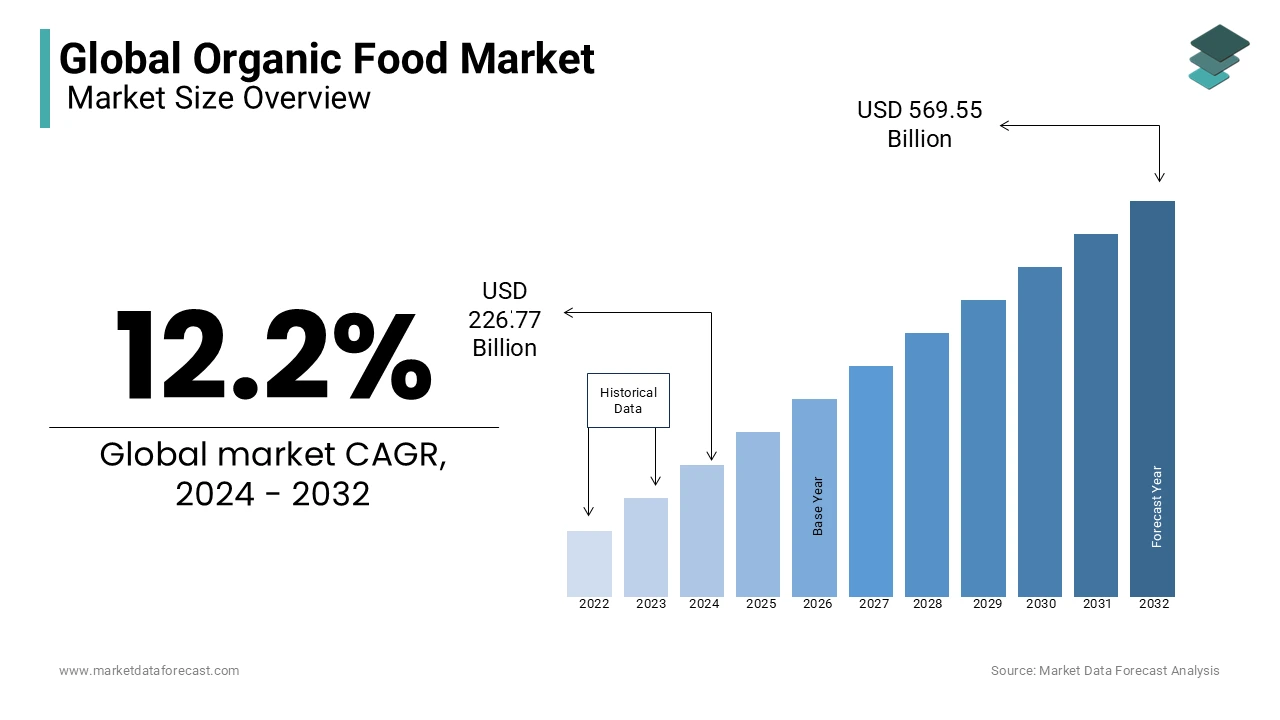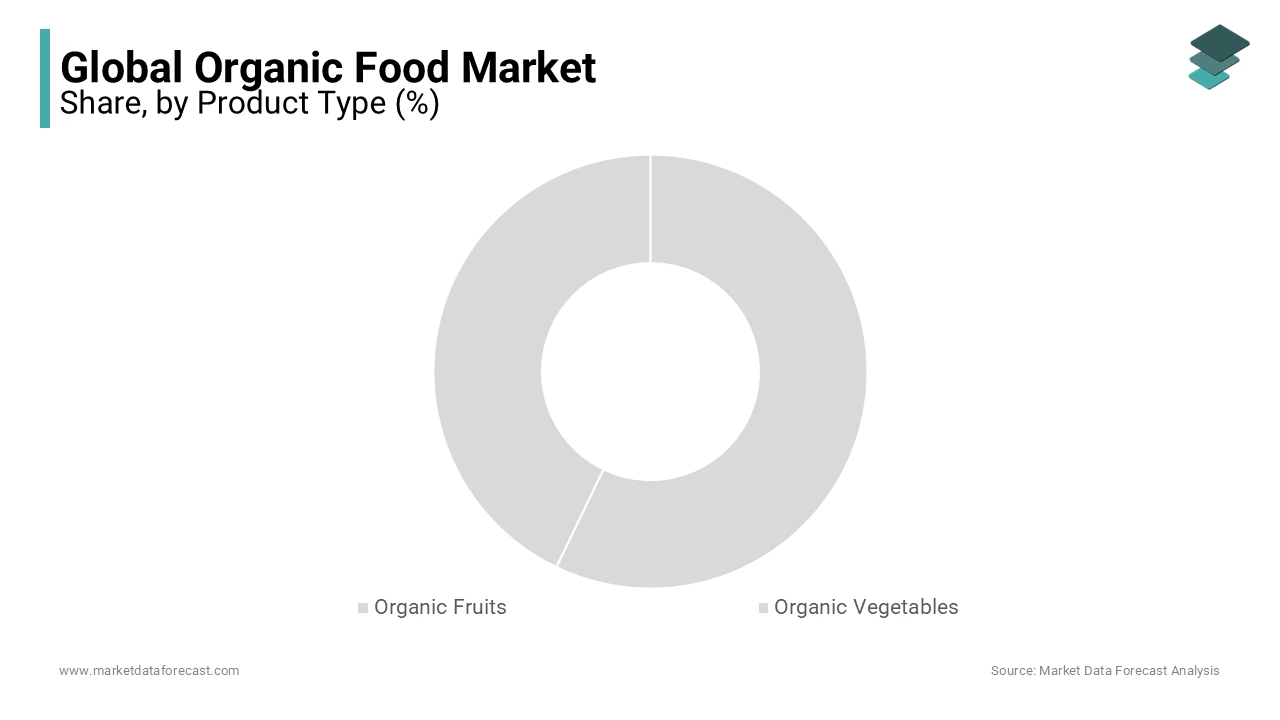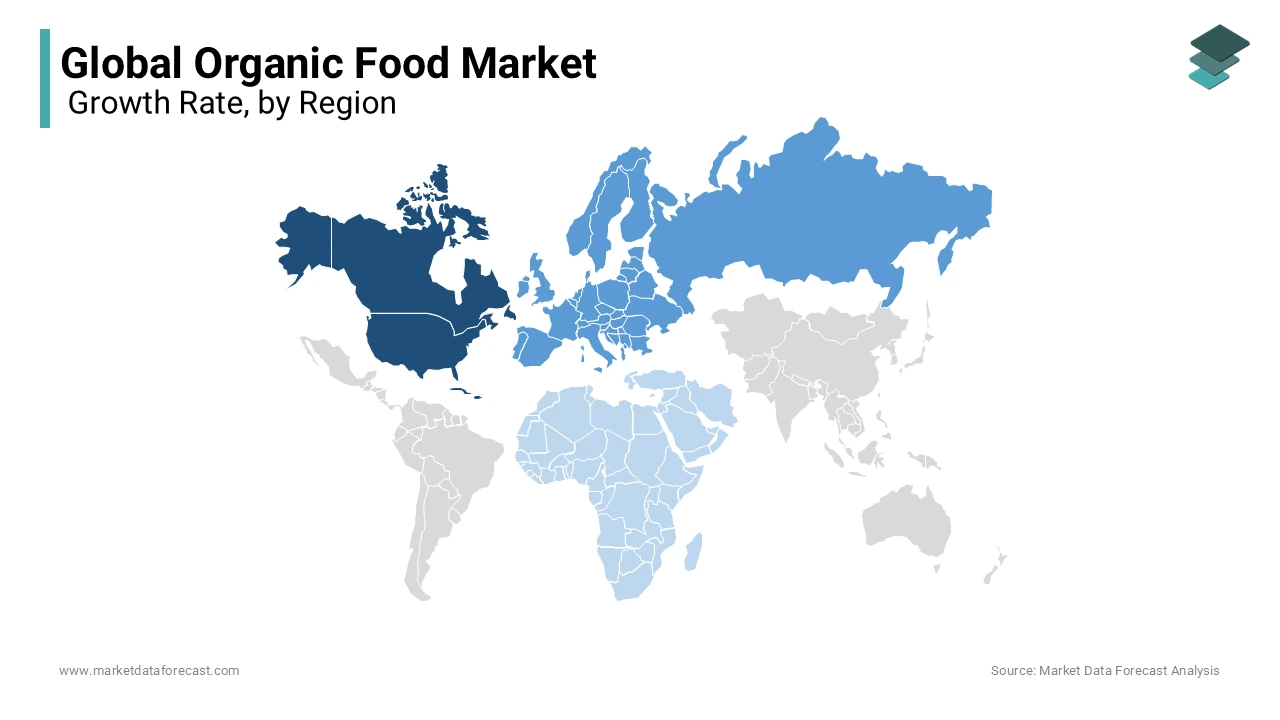Global Organic Food Market Size, Share, Trends & Growth Forecast Report - Segmented By Product Type (Organic Fruit and Organic Vegetable), Form, End User, and Region (North America, Europe, Asia Pacific, Latin America, and Middle East and Africa) - Industry Analysis (2025 to 2033)
Global Organic Food Market Size
The global organic food market size was valued at USD 226.77 billion in 2024, and the global market size is expected to reach USD 254.44 billion in 2025 and USD 639.04 billion by 2033, growing at a CAGR of 12.2% from 2025 to 2033.

Presently, the organic food market is rapidly growing with a progressive inclination of people of all age groups towards fresh and high-nutrition values. Today’s generation is seeking to eat only fresh food products that are healthy and chemical-free. This shift is also due to the extensive use of synthetic ingredients, food-grade color, and fertilisers which consequently lead to harmful impacts on health. Also, considering the ongoing situation of the world economy, the Indian organic food market has experienced a tremendous rise after COVID-19. As per the 2022 survey performed in 187 nations following organic agriculture through the international resource data under the Research Institute of Organic Agriculture (FiBL) as well as the International Federation of Organic Agriculture Movements (IFOAM), organic food in the country is produced in 2.6 Mn hectares, which is the fifth biggest in the world. Additionally, China with 318’700 hectares, France with 227’877 hectares, and Spain with 197’551 hectares are the top three countries with the highest rise in organic agricultural land worldwide.
In the world of the latest technology, farmers are reverting to age-old farming practices for a more significant benefit to the human race. In this world, everything is powered by modern technologies. A new crop of well-conscious customers are increasingly aware that pesticides and other food additives can have harmful effects, and producers are now reporting old agricultural practices of producing what is considered organic food.
MARKET DRIVERS
The increasing popularity of the easy availability of organic food products in urban areas in developed and emerging countries is a major factor propelling the growth rate of the market. In urban areas, the prominence of eating only healthy food to maintain well-being in their busy lifestyle schedule is growing. Several research reports show that organic food products are directly attributed to lowering the risk of several chronic diseases. The rising prevalence of many chronic illnesses, especially among young people, is subjected to changes in lifestyle that drastically impelled the increase of the production rate of organic foods. Creating awareness through social media is also one of the prominent factors that is leveraging the market’s growth rate. Social media influencers have been putting efforts into spreading awareness of the advantages of eating organic food in recent times, and people are also more inclined to adopt these changes in their daily routines. Going back to adopting the traditional methods in producing food products, especially in farming using modern equipment, is gearing up the growth rate of the market. In those traditional days, all the food products used to be highly organic, but with the rising global population, the need to produce a high quantity of food products using different chemicals and pesticides improves productivity. This has led to the production of harmful food products that also impacted the environment negatively. The rise in awareness towards going back to the traditional methods of producing food products is anticipated to promote the growth rate of the market. The food and beverage industry is giving many people the opportunity to launch various food products according to consumer preferences, which also elevates the market’s growth rate.
In the most developed countries like US, people apparently looking for additive or chemical free food products. According to the latest statistics, more than 30% of the Americans prefer only organic food products which is amplifying the market’s growth rate in the coming years.
The potential need to adopt organic food products due to the rising risks associated with the chemicals and pesticides used for inorganic food products is setting up a positive scope for the organic food market to grow in the coming years. It is highly important to adopt new techniques in the food and beverage industry to reduce environmental pollution through the use of various harmful chemicals. Organic foods are highly beneficial for people who have allergic symptoms to foods, chemicals, and preservatives. People who completely depend on eating only organic food products can see many health benefits that they encounter, creating huge opportunities for the market. The rising number of stores selling organic food products rather than conventional food products, along with the growing people’s preferences towards them, is escalating the growth rate of the market.
MARKET RESTRAINTS
Lack of proper awareness of the use of advanced techniques in producing organic food products slowly degrades the growth rate of the market. Producing organic food requires skilled professionals to look after the process using the latest technologies, and the lack of those people in the food and beverage industry can pose challenges for the market's key players. Along with this, the lack of easy availability of the supplements needed for the food products due to disruptions in the supply chain can hamper the market’s growth rate.
The high cost of organic food products that common people could not afford those is another factor that is impacting negatively on the growth rate of the organic food market. The procedure involved in producing the organic foods is bit difficult as there are high chance to get contaminated in few days. These food products should be delivered in meantime as there will be no chemical or preservatives used to store for longer days. This could impede the growth rate of the organic food market.
The potential need to adopt organic food products due to the rising risks associated with the chemicals and pesticides used for inorganic food products is setting up a positive scope for the organic food market to grow in the coming years. It is highly important to adopt new techniques in the food and beverage industry to reduce environmental pollution through the use of various harmful chemicals. Organic foods are highly beneficial for people who have allergic symptoms to foods, chemicals, and preservatives. People who completely depend on eating only organic food products can see many health benefits that they encounter, creating huge opportunities for the market. The rising number of stores selling organic food products rather than conventional food products, along with the growing people’s preferences towards them, is escalating the growth rate of the market.
MARKET CHALLENGES
The loss of soil fertility, poor nutrition management, and weed control derail the growth trajectory of the organic food market. Every year, approximately 24 billion tons of fertile ground are lost because of soil erosion. It is 3.4 tons gone each year for each individual on the earth. As per the Food and Agriculture Organization of the United Nations, it is projected that soil erosion can result in the loss of up to 50 per cent of crop yield. Land degradation and Soil erosion present a key risk factor to the world’s food security and to the attainment of the Sustainable Development Goals (SDGs) which compromise the health of not less than 3.2 billion individuals globally.
Apart from this, another issue affecting the market expansion is the rising inflation rate. This has compelled several organic purchasers to be selective. Traditional oranges and bananas, for instance, with their defensive skins, can be considered acceptable by organic buyers on limited funds, but on the other hand fresh tomatoes and berries, not so much.
MARKET OPPORTUNITIES
The growth in customer demand, expansion of natural products, and Stricter standards and certifications are opening up new avenues for the organic food market. With surging cognizance of the health and environmental effects of highly chemical-based farming customs or exercises, more customers are choosing for organic items. This increase in demand exhibits an interesting opportunity for organic cultivators to expand their business and activities and attain wider markets. Western Economies like the United States, Canada, Germany and other European nations are providing major perspectives for the market players. For instance, in the United States organic industry, food plays a primary role, depicting over 90 percent of complete sales from organic products. As per the 2022 data, organic food sales attained a huge mark of 61.67 billion dollars, witnessing an outstanding rise of 4.3 percent from the prior period. But, Asia Pacific countries such as India, China, Indonesia, etc. hold more potential due to their inherent preference for natural food and the presence of a large consumer base.
REPORT COVERAGE
|
REPORT METRIC |
DETAILS |
|
Market Size Available |
2024 to 2033 |
|
Base Year |
2024 |
|
Forecast Period |
2025 to 2033 |
|
CAGR |
12.2% |
|
Segments Covered |
By Product Type, Form, End User, and Region |
|
Various Analyses Covered |
Global, Regional and Country Level Analysis; Segment-Level Analysis; DROC; PESTLE Analysis; Porter’s Five Forces Analysis; Competitive Landscape; Analyst Overview of Investment Opportunities |
|
Regions Covered |
North America, Europe, APAC, Latin America, Middle East & Africa |
|
Market Leaders Profiled |
Spartan Stores Inc, Clif Bar & Company, Kroger, Inc, Dole Food Co., Inc, Frito-Lay, Newman's Own Inc, Dean Foods, Bio Valley, AMCON Distributing Co, Amy's Kitchen, Whole Foods Industry Inc, Hain Celestial Group Inc, United Natural Foods Inc |
SEGMENTAL ANALYSIS
By Product Type Insights
The organic vegetables segment is greatly influenced in holding the prominent share of the market, whereas the organic fruits segment is likely to have the highest CAGR by the end of 2033. Consumers' awareness of constantly relying on only eating healthy food products rather than chemically produced plant products is inclined to leverage the growth rate of the market. Fruits and vegetables are rich in nutrients and promote health benefits that eventually lower the risk of cardiovascular diseases and other chronic diseases, greatly attracting customers to buy organic fruits and vegetables even though they are high in price.

By Form Insights
The fresh segment is ruling with the dominant share of the organic food market. Consumer preferences for fresh food products that are fresh, organic, and naturally made substantially increase the growth opportunities for the fresh segment. The organic products are frozen to make their shelf life a little longer but do not use any kind of preservatives. Therefore, the frozen segment is also likely to have prominent growth opportunities in the coming years.
By End-User Insights
Residential segment is inclined to have largest share of the organic food market. The demand for the organic food products is very high in residential areas where the launch of various applications in smart phones to deliver the food products to the door step is attributed in lavishing the growth rate of the market
As the market trend shifts, numerous people are deeply interested in organic and natural goods that are necessary to stimulate the world market in organic fruit and vegetables. During the prediction period, the market is expected to raise awareness of the health benefits of organic fruit and plants. It should also be hoped that the awareness of related health benefits in the form of organic nutrients, nutritious breakfast cereals, baby food, etc.
REGIONAL ANALYSIS
North America is expected to hold the dominating share of the organic food market during the forecast period due to the growing popularity of organic food and organic beverages. The growing awareness of the health benefits of consuming organic food products. According to the Organic Trade Association, the United States is the largest market for organic food, accounting for more than half of the market for organic products consumed worldwide. The rapid growth of the food and beverage industries in the region is expected to lead to an increase in the demand for organic food by this industry, which is expected to further contribute to the growth of the organic food market Size.

Europe stands for second in the market with one of the highest amounts of revenue. The Asia-Pacific region is expected to register the fastest growth during the analysis period. Factors such as the growing demand for organic food, the increase in retail stores, the increase in purchasing power parity, and the expansion of the middle-class population are driving the growth of this segment. Latin American countries offer many expansion opportunities to the main players.
Latin America region is expected to experience significant growth in the organic food and beverage market due to growing consumer awareness, and the increase in organic food and beverage varieties such as organic food and beverage.
Middle East and Africa are one of the main emerging regions, which will generate significant opportunities in the market during the anticipated period due to the increase in the population's disposable income, the changing lifestyle, and the increased preference for quality food products. The region is expected to experience moderate growth during the forecast period due to the above factors.
KEY PLAYERS IN THE ORGANIC FOOD MARKET
Spartan Stores Inc., Clif Bar & Company, Kroger, Inc., Dole Food Co., Inc., Frito-Lay, Newman's Own Inc., Dean Foods, Bio Valley, AMCON Distributing Co, Amy's Kitchen, Whole Foods Industry Inc, Hain Celestial Group Inc. and United Natural Foods Inc. are some of the prominent companies in the global organic food market.
RECENT HAPPENINGS IN THE MARKET
- In May 2025, Fresh Del Monte Produce Inc. and Vellsam Materias Bioactivas reported the contract signing for a collaboration that will examine how to optimise the application of pineapple residues by Fresh Del Monte by means of biofertilizers. The Fresh Del Monte-led collaboration, functioning within the name called De l’Ora Bio, reported this partnership with the commencement of a biofertilizer factory in Kenya, marking the primary step in the alliance’s biofertilizer manufacturing endeavour.
MARKET SEGMENTATION
This research report on the global organic food market has been segmented and sub-segmented based on product type, form, end user & region.
By Product Type
- Organic Fruits
- Organic Vegetables
By Form
- Fresh
- Frozen
By End-User
- Residential
- Commercial
By Region
- North America
- Asia Pacific
- Europe
- Latin America
- Middle East and Africa
Frequently Asked Questions
1.What are the benefits of organic food?
Organic food is often perceived to be healthier, as it is free from synthetic chemicals and pesticides. Additionally, organic farming practices prioritize environmental sustainability and animal welfare.
2.How is organic food certified?
Organic food products are typically certified by regulatory agencies or third-party certification bodies. Certification involves adherence to specific standards regarding farming practices, inputs, and processing methods.
3.Is organic food more expensive?
Organic food products often come with a premium price tag due to higher production costs associated with organic farming practices. However, prices may vary depending on factors such as location and product availability
Related Reports
Access the study in MULTIPLE FORMATS
Purchase options starting from $ 2500
Didn’t find what you’re looking for?
TALK TO OUR ANALYST TEAM
Need something within your budget?
NO WORRIES! WE GOT YOU COVERED!
Call us on: +1 888 702 9696 (U.S Toll Free)
Write to us: [email protected]